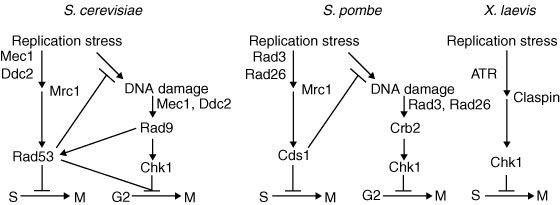Replication stress can affect two cell cycle checkpoints.
Keywords
Flag Inappropriate
Delete Content

Replication stress can affect two cell cycle checkpoints.
Alcabasas et al. (2001) demonstrated that the budding yeast protein Mrc1 is the replication checkpoint transducer, bringing Rad53 to Mec1. This action allows for Rad53 phosphorylation (activation), and triggers the S phase checkpoint. The process is similar in fission yeast: Mrc1 is the transducer of the phosphorylation signal from Rad3 to Cds1. In addition, Xenopus CLASPIN transduces the ATR signal to CHK1. However, prolonged RF stalling leads to DNA damage; alternatively, the fork may collapse if Rad53 (Cds1 in fission yeast, or Chk1 in metazoa) is absent, and such collapses cause DNA DSBs that cannot be repaired with RF restart. This DNA damage shifts the signal cascade to the DNA damage response branch. In yeast, the result is the activation of Chk1 proteins (which have a different role from metazoan Chk1) in a DNA damage–specific signaling pathway. Induction of the DNA damage pathway halts progression into metaphase while promoting DNA repair through appropriate repair mechanisms.
This image is linked to the following Scitable pages:
At a stalled DNA replication fork, how is replication restarted after DNA damage has been resolved?





















Comments
CloseComments
Please Post Your Comment